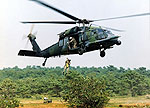AF special operations group key to aid effort after Typhoon Haiyan
 The Air Force's 353rd Special Operations Group opened a third airfield in Borongan, Republic of the Philippines Nov. 18, to facilitate a more efficient distribution of relief supplies to outlying areas as part of Operation Damayan.
The Air Force's 353rd Special Operations Group opened a third airfield in Borongan, Republic of the Philippines Nov. 18, to facilitate a more efficient distribution of relief supplies to outlying areas as part of Operation Damayan.
The group has opened airstrips at Ormoc, Guiuan and Borongan on Samar Island, located among the Philippines' central islands. The nine-member team has made it possible for more than 1,000 Philippine citizens to be airlifted daily and nearly 290,000 pounds of food and supplies to reach those in need.
"Our purpose is to get in there and have an airfield established immediately," said Capt. Jon Shamess, with the 353rd SOG. "We work closely with the Philippine military and civilian air traffic control to ensure the safety and efficiency of the airport."
To ensure the safety and efficiency of the airport, the 353rd SOG Airmen had to assess the suitability of the runway for aircraft.
"…We check surface quality, and for obstacles and hazards that may be dangerous for the aircraft," said Master Sgt. Tobin Berry, a 353rd SOG combat controller.
Once they re-activated the third runway, the airstrip quickly took on as many as 115 relief sorties a day.
"The most challenging part was having that much traffic with a single runway," said Staff Sgt. Aaron Davis, a combat controller from the 353rd SOG.
"A typical Humanitarian Assistance Disaster Relief mission averages about 30 to 50 sorties a day," Berry added.
With limited parking space taken up by several international militaries and relief organizations, combat controllers at times found themselves with up to nine aircraft on the ground along with five aircraft circling above waiting to land.
According to Davis, the hardest part initially was working the heavy traffic while also coordinating the offload of food and supplies along with the movement of evacuees. That's where the rest of the team played a vital role.
In addition to combat controllers, each team has a pararescue and survival, evasion, resistance and escape specialist, as well as a translator. The unit also features a Deployed Aircraft Ground Response Element team member, specially trained to provide security for Air Force Special Operations Command aircraft and support special operations contingency deployments.
While combat controllers directed aircraft, other team members worked with the Philippine military and police to continually move people and supplies.
"They were vital to the success of the coordination of offload and on load of passengers and cargo while coordinating with the Philippine military," Berry said. "They really made it happen while working outside of their primary (duties)."
The team is only on site for as long as it takes to get the airport running smoothly. When ready, they will transition their assistance role to the III Marine Expeditionary Brigade or the Civil Aviation Authority of the Philippines; both will provide more long-term assistance to the Philippines before the special tactics teams move on to the next airport.
"Every few hours we reached a new phase in the effort as more people, more supplies and more capabilities arrived," Shamess said. "We're glad to be able to provide the Philippine people with critical (help) and work with them to help their country recover from such a devastating typhoon like this."